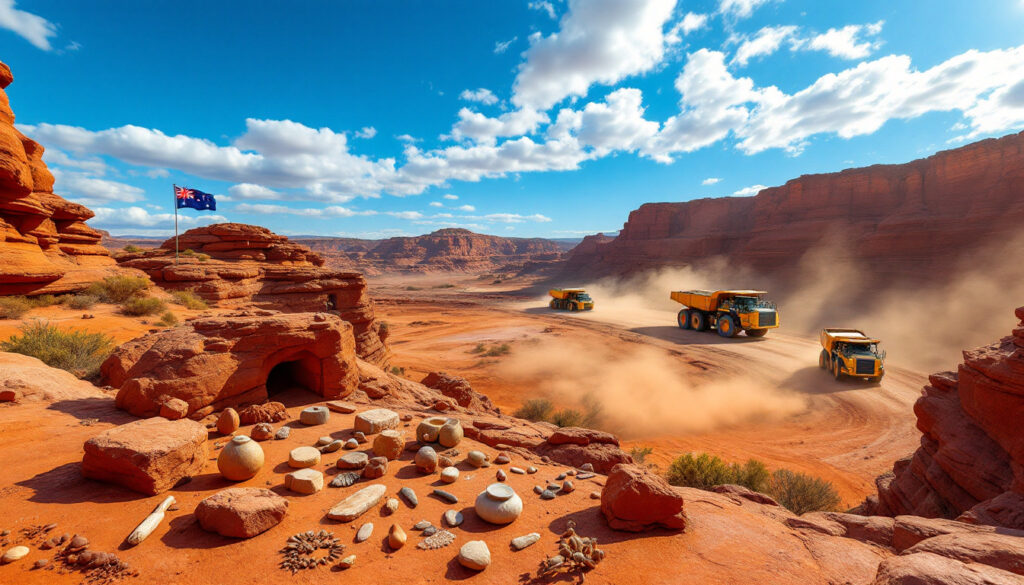The Juukan Gorge Disaster: Rio Tinto's Broken Promises to Indigenous Communities
The May 2020 destruction of the Juukan Gorge rock shelters stands as one of Australia's most devastating cultural heritage losses and a defining moment for Indigenous relations in the global mining industry. Five years after Rio Tinto's promises of reform, many Aboriginal groups claim the mining giant continues to fail its commitments to Indigenous communities.
The Destruction and Its Significance
In May 2020, Rio Tinto deliberately blasted the 46,000-year-old Juukan Gorge rock shelters in Western Australia's Pilbara region to access approximately 8 million tonnes of high-grade iron ore valued at $135 million. The caves contained irreplaceable archaeological treasures, including a 4,000-year-old hair belt with genetic links to present-day traditional owners.
The destruction occurred despite Rio Tinto knowing the exceptional cultural significance of the site since at least 2014, when archaeological investigations revealed artifacts dating back to the last Ice Age. The company had obtained legal permission under Western Australia's outdated Aboriginal Heritage Act of 1972, which allowed sites to be damaged regardless of cultural importance if ministerial permission was granted.
The blast triggered international condemnation, investor backlash, and a parliamentary inquiry that exposed systemic failures in Rio Tinto's heritage management and decision-making processes. The scandal ultimately forced the resignation of CEO Jean-Sébastien Jacques, two other senior executives, and eventually board chair Simon Thompson.
Promises Made After the Destruction
In the aftermath of the Juukan Gorge disaster, Rio Tinto made numerous public commitments to reform its relationships with Indigenous communities:
Key Corporate Commitments
- Pledged to modernize agreements with all 60+ Indigenous groups on whose lands they operate globally
- Promised to implement stronger heritage protection protocols across all operations
- Committed to greater transparency in dealings with traditional owner groups
- Vowed to restructure leadership and decision-making processes
- Established new executive accountability for Indigenous relations
These promises came with specific remediation efforts focused on the Puutu Kunti Kurrama and Pinikura (PKKP) people, including public apologies, rehabilitation commitments for the Juukan area, and confidential financial compensation.
The company also implemented mandatory cultural heritage training for over 10,000 employees and claimed to have revised its internal approval processes to prevent similar incidents.
Allegations of Continued Failures
Despite these public commitments, allegations have emerged that Rio Tinto continues to fall short on its promises to modernize agreements with Indigenous groups.
The Mesa J Mine Controversy
At Rio Tinto's 2025 Annual General Meeting, Deanna McGowan from the Robe River Kuruma Aboriginal Corporation leveled serious allegations against the company:
"Rio has cheated us out of 17 years of payments," McGowan stated, explaining that while the Mesa J mine had operated on their lands for over 30 years, the corporation had only received compensation for three years.
McGowan further alleged that Rio Tinto executives had told elders approximately 20 years prior that the Mesa J mine would "soon close," making a comprehensive agreement unnecessary. However, the mine continued operations for decades without proper compensation to the traditional owners.
Limited Progress on Modernizing Agreements
Rio Tinto chair Dominic Barton acknowledged at the 2025 AGM that while relationships with most Indigenous groups were positive, "a small number remain challenged." This diplomatic phrasing contrasts sharply with the experiences reported by groups like the Robe River Kuruma.
The company's production reports continue to indicate that operations remain "subject to the timing of approvals for planned mining areas and heritage clearances" — suggesting ongoing tensions with traditional owner groups whose consent is required for mine expansions.
Systemic Issues in Mining-Indigenous Relations
The Juukan Gorge incident and subsequent revelations have exposed fundamental problems in how mining companies engage with Indigenous communities across Australia.
Historical Power Imbalances
Many existing agreements between miners and Aboriginal groups were negotiated decades ago under vastly different circumstances:
- Indigenous groups often had limited legal recognition and fewer resources for negotiation
- Many agreements contained "gag clauses" preventing groups from speaking publicly about heritage damage
- Compensation formulas frequently undervalued both the resources extracted and the cultural heritage impacted
- Limited transparency requirements allowed companies to avoid public scrutiny
Parliamentary inquiries following Juukan Gorge found that such problematic agreements were widespread across the industry, not limited to Rio Tinto.
Inadequate Heritage Protection Systems
Western Australia's Aboriginal heritage protection system was fundamentally flawed, prioritizing mineral extraction over cultural preservation:
- The 1972 Act allowed destruction of significant sites with ministerial approval
- Traditional owners had limited input into the approval process
- Once granted, permits had no expiration date or review mechanism
- No provisions existed for reconsidering approvals when new information emerged
While Western Australia passed the Aboriginal Cultural Heritage Act in 2021 to address these issues, implementation challenges remain, and many Indigenous groups continue to advocate for stronger federal protections.
Operational and Financial Impacts for Rio Tinto
Rio Tinto's failure to fulfill its commitments to Indigenous communities has tangible business implications:
Production Uncertainties
The company's financial guidance now explicitly acknowledges dependency on "timing of approvals for planned mining areas and heritage clearances." This represents a significant operational constraint:
- Delays in obtaining heritage approvals can disrupt production schedules
- Uncertainty around agreement modernization creates planning challenges
- Potential for project delays if agreements cannot be reached with traditional owner groups
- Increased costs associated with heritage management and Indigenous engagement
Investor and Reputation Concerns
The ongoing issues with Indigenous relations continue to affect Rio Tinto's standing with investors and stakeholders:
- ESG challenges now view Indigenous relations as a material risk factor
- Heightened scrutiny of heritage management practices across the company's global operations
- Potential liability for past underpayments if more groups come forward with similar claims
- Competitive disadvantage if other miners establish more progressive Indigenous relations models
Major institutional investors, including Australian superannuation funds, have placed Rio Tinto on watch lists for ESG concerns specifically related to Indigenous engagement.
Industry-Wide Reforms After Juukan Gorge
The Juukan Gorge disaster has catalyzed changes across the mining sector:
Corporate Responses
- Major miners including BHP and Fortescue pledged to update land-use agreements with traditional owner groups
- Approximately 80% of ASX-listed miners revised their heritage protection policies
- Over $2 billion has been allocated to Indigenous partnerships industry-wide
- Greater investor attention to Indigenous relations as part of ESG considerations
Regulatory Changes
- Western Australia replaced its 1972 heritage law with the Aboriginal Cultural Heritage Act 2021
- Increased scrutiny of "gag clauses" in agreements that prevented Aboriginal groups from speaking publicly
- Recognition that many Indigenous groups were systematically underpaid royalties
- Pressure for more equitable benefit-sharing arrangements and co-management models
Despite these reforms, implementation remains inconsistent, and many Indigenous groups argue that structural inequalities persist in their relationships with mining companies.
The Path Forward for Indigenous-Mining Relations
The mining industry's relationship with Indigenous communities is undergoing a fundamental transformation, with increasing recognition that genuine partnership is essential for sustainable operations.
Evolving Standards and Expectations
- Shift from transactional relationships to true co-management of lands and resources
- Fair compensation reflecting the full value of resources extracted and heritage impacts
- Meaningful inclusion in decision-making processes at all stages of mine planning and operation
- Recognition and incorporation of Indigenous knowledge in environmental management
Key Challenges Ahead
- Addressing historical inequities in past agreements
- Developing consistent standards for cultural heritage valuation
- Balancing resource development with heritage protection
- Ensuring regulatory frameworks support equitable partnerships
- Building genuine trust after decades of problematic relations
The tension between mineral extraction and cultural heritage protection remains, but innovative models are emerging that seek to create sustainable value for Indigenous communities while enabling responsible resource development. Furthermore, understanding market reaction dynamics helps explain how Rio Tinto's share price responded to the Juukan Gorge incident.
FAQ: Rio Tinto and Juukan Gorge
Why was the Juukan Gorge destruction legally permitted despite its cultural significance?
The destruction occurred under Western Australia's Aboriginal Heritage Act of 1972, which allowed companies to apply for permission to damage or destroy sites regardless of cultural significance. Rio Tinto had obtained legal approval in 2013, but subsequent archaeological discoveries in 2014 revealed the site's exceptional importance. Despite this new information, the company proceeded with destruction because the legal permission remained valid, highlighting fundamental flaws in the heritage protection system.
What changes have been made to prevent similar incidents in the future?
Western Australia passed the Aboriginal Cultural Heritage Act in 2021 to replace the outdated 1972 legislation. The new law requires meaningful consultation with traditional owners and introduces stronger protections. Mining companies have also implemented internal reforms, including enhanced heritage assessment processes, cultural heritage training for executives, and greater Indigenous involvement in decision-making. However, implementation challenges remain, and many Indigenous groups continue to advocate for stronger native title challenges for better protection.
How do modern mining agreements with Indigenous groups differ from past arrangements?
Modern agreements increasingly focus on genuine partnership rather than mere compensation. They typically include provisions for ongoing consultation, cultural heritage protection protocols, employment and business development opportunities, and more equitable financial arrangements. Importantly, they avoid the problematic "gag clauses" that prevented Indigenous groups from speaking about heritage concerns and include mechanisms for regular review and updating as circumstances change.
What specific benefits should Indigenous communities receive from mining on their traditional lands?
Comprehensive benefits should include fair financial compensation (through royalties, equity participation, or other mechanisms), employment and training opportunities, business development support, infrastructure investments, cultural heritage protection, environmental co-management, and meaningful participation in decision-making. The specific arrangement should be determined through genuine negotiation with each Indigenous group based on their priorities and aspirations.
Note: The destruction of Juukan Gorge represents not just the loss of archaeological treasures but a profound cultural wound for the traditional owners. While financial compensation and policy changes are important, many Indigenous leaders emphasize that certain cultural losses can never be truly remediated.
Looking ahead, the mining industry faces significant governance challenges in their relationships with Indigenous communities, which will likely influence industry trends 2025 and beyond. Additionally, the Australian government's response to the Juukan Gorge incident has created new frameworks for heritage protection that will shape mining operations for decades to come.
Want to Be Alerted About the Next Major Mining Discovery?
Don't miss potential wealth-creating opportunities in the ASX mining sector. Discover how our proprietary Discovery IQ model provides real-time alerts on significant mineral discoveries, giving you a crucial market advantage before the broader market reacts – explore our past successful discoveries to see how our system could benefit your investment strategy.




